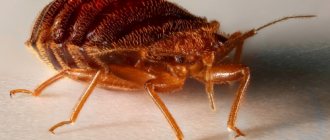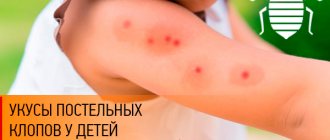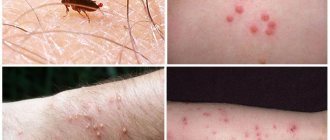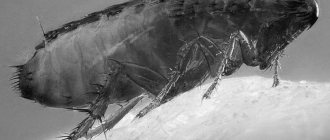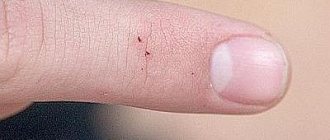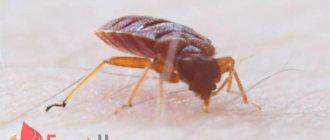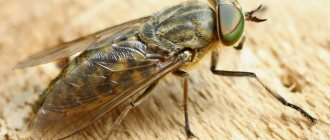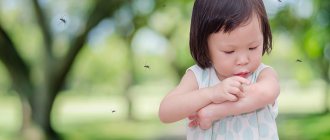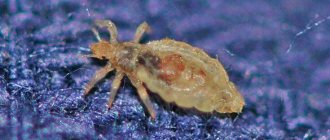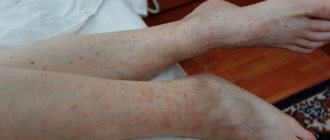Everyone has their favorite season, but many would agree that everyone enjoys summer.
Summer is a time of vacation and holidays; people of all ages try to spend as much time as possible outdoors.
However, this pleasant time can be overshadowed by various minor troubles. Such not very pleasant little things include hordes of blood-sucking creatures.
Their bites can bring many unpleasant consequences. Moreover, if after a mosquito bite everything ends quite quickly and easily, then a bite from a smaller midge can bring a lot of worries, and even bring you to the hospital.
Midges, like mosquitoes, are two-winged insects. There are now about 1,800 species of midges in the world. Only females bite; they need this for reproduction. The life cycle of midges is relatively short, only 1 month.
The bite of midges, unlike their closest relatives, is more dangerous because they capture a piece of skin. And at the site of the bite you can see a wound in which part of the epithelium is missing.
After a bite, an allergic reaction occurs; in some it is stronger, in others it is less pronounced. The midge's saliva contains poison, which causes such a strong allergic reaction.
Also dangerous are diseases that midges can carry in their saliva (cholera, anthrax, etc.). But in our latitudes, midges that carry serious diseases are practically never found.
Getting to know the insect
Midges are small insects whose size barely reaches 5 mm.
Most species have completely miniature sizes - 2 mm. They live everywhere, with the exception of Antarctica. All phases of development, until the insect reaches the imago stage, midges spend in an introductory environment. The family has about 1,800 species; the European temperate climate is inhabited mainly by fruit flies, whiteflies, and sciarids. Only a knowledgeable entomologist can determine the differences between them. The poor fellow, bitten by a midge, has no time to determine the species, and all the vileness looks the same to him. Midges
Interesting!
In most species, only female midges feed on the blood of warm-blooded insects. Males eat exclusively fruit or flower nectar.
People who live near bodies of water or travelers in the taiga and tundra are most aware of how midges bite. As experienced people say, a midge in the taiga will be worse than a mosquito. Hordes of insects are called nothing more than midges. Rivers and lakes with running water are mandatory conditions for the reproduction of insects. Females lay their eggs on plant stems and stones in ponds. Some individuals specifically go underwater to lay offspring. Other females do not bother themselves with diving skills and drop their eggs on the fly. If you take a portion of water from the bottom of a river or any other body of water, using a magnifying glass you can see tiny worm-like white larvae.
The peak of activity begins in mid-April, early May and ends only by the end of June. In the northern regions, midge activity decreases after snowfall. Insects feed only during the daytime in sunny weather. On a rainy, cloudy day, no midge activity was recorded at night. Insects live in flocks containing myriads of individuals. People and animals suffer from midge bites. There are known cases where tens of thousands of cattle died from attacks by the Colombian midge in the Danube countries.
Midges
Review
“One day in late spring, my family and I came to visit relatives living on the banks of the small river Khoper. Suspecting nothing, we decided to get out into nature and relax on the river bank. We drove up to the shore and, inspired by the view of the spring landscape, quickly got out of the car. And then it started! Swarms of small midges swarmed around us and began to bite us furiously, tiny insects getting into our mouths and noses. The child immediately ran into the car, and we adults still tried to resist. But neither running fast nor waving branches helped. I had to leave the inhospitable shore; it’s good that at least no one was allergic to the midge bite. Local residents then laughed at us and said that the midge would disappear only after the flood and the June haymaking.”
Valentina Vladimirovna, Balashov
What kind of insect is a midge?
According to the zoological classification, midges belong to the same order as ordinary flies and mosquitoes. The peculiarity of midges lies in their small size and saliva, which is poisonous to humans, with which they lubricate the bite site. These small blood-sucking insects are midges along with horse flies, mosquitoes and mosquitoes. In total, there are about 1,800 species of midges in nature, and they live on all continents of the globe with the exception of Antarctica.
Midges live in areas where there are bodies of water with running water - rivers, streams. The larvae are very small and transparent, almost invisible in the water. They move through aquatic plants, feeding on microscopic representatives of the animal world. Then the larvae pupate, and after some time an adult is born. Midges live for about a month. Like mosquitoes, male midges feed on plant nectar, while females drink the blood of mammals and birds - they need this for the development of future offspring.
Small bloodsuckers are active in summer on hot days and in the morning. They wait for their prey on tall stems of grass. When attacking a person, insects are guided by the smell of sweat. Attacks are carried out en masse, so often when a midge bites the victim needs help.
Midge life cycle and description
Adult black flies are small insects, 1 to 5 mm in length, ranging in color from black to various shades of gray or yellow.
Adults
transition from egg to larva, pupa, adult stage. The full cycle takes two to six weeks, depending on environmental conditions. Adults are most numerous near breeding sites. The average flight distance of a female is 2 km, for males it is less than half this distance.
Eggs
Males and females feed on nectar, but females require blood to mature their eggs. They feed at dawn and dusk. Some species are active during the day.
The number of eggs produced varies depending on the species, up to 450 eggs in one batch and up to seven batches over a lifetime.
Females lay eggs on vegetation just below the surface of the water. Adults live for several weeks in natural conditions.
Larvae
The larvae are worm-shaped, creamy white, approximately 2 to 5 mm long. They need water, air, food. They are not strictly aquatic or terrestrial and cannot develop without moisture. Present in and around salt marshes, swamps, on the banks of streams, ponds, and in dirty substrates. They feed on small organisms.
The larvae do not develop inside humans or other animals.
Some species can produce their first batch of eggs without their first meal (blood).
Simulium slossonae flies four to eight miles from its breeding site in search of food, then returns after feeding to reproduce and lay eggs. Thus, the problem can be transferred over considerable distances.
How a blood-sucking insect bites
Midges, unlike gadflies, horseflies and mosquitoes, do not bite the skin of humans or animals. Attracted by the smell of sweat, they cut off the top layer of the epidermis like a knife, leaving wide and shallow wounds. What is dangerous is not the way the midge bites, but the consequences caused by microtraumas.
This is interesting: The toxicity of midge saliva depends on its identity. After an attack by some insects, only a slight swelling remains on the skin, while the bite of others can cause the development of severe and deadly allergic reactions - Quincke's edema and anaphylactic shock.
After cutting off a piece of skin, the insect instantly secretes saliva containing various organic ingredients. Some of them prevent the rapid formation of blood clots, while others have anesthetic properties. The adult and child do not feel any pain or discomfort while the midge feeds on the escaping blood and lymph. Only the swelling and unbearable itching that developed after a couple of hours indicate that the person was attacked.
The analgesic effect of saliva does not allow the midge to be destroyed, since a person simply does not feel its presence. A whole swarm of insects flocks to the smell of blood, which increases the severity of the consequences of bites due to the injection of new portions of poison.
Features of bloodsucker bites
As noted above, only females can bite. They need blood to mature their eggs. Midge bites are comparable to a surgical procedure. They do not pierce the skin, but literally gnaw it out, at the same moment the insects inject an anesthetic substance, which allows a person not to experience pain until the parasites have had their fill. At the same time, the annoying bloodsucker introduces an enzyme that prevents blood clotting.
The insect's saliva contains toxic substances for the human body, as a result of which swelling and redness, burning and severe itching appear at the site of the lesion. Numerous bites can cause fever, swelling of internal organs and, in rare cases, cause death.
Midge bite in the eye
The reaction to a midge bite varies from person to person and depends on age, pain threshold, number of lesions, and tendency to allergies. Severe itching causes the desire to scratch the areas caused by midge bites. Even an adult cannot resist this, let alone children who tear apart the affected areas until blood appears. As a result, the situation is aggravated by the penetration of bacteria. Photos of a midge bite are presented below.
What determines the severity of the reaction to a bite?
The reaction to a midge bite is expressed in different ways. This depends on a number of factors.
Age
Adults tolerate insect venom more easily than children. They more often exhibit local reactions. In childhood, the risk of developing general intoxication of the body increases. Midges pose a particular danger to infants. There have been cases where, with multiple bites, this category of patients developed Quincke's edema.
Immunity
Any toxin can trigger an immune response. If the body's protective functions are weakened, then the reaction to midge poison will be more pronounced.
Increased sensitivity to midge saliva
Sometimes the body exhibits intolerance to the components of insect saliva. This applies not only to midges, but also to other blood-sucking parasites. In this case, the reaction to toxins cannot be predicted.
Pregnancy and lactation
During this period, the immune defense of the mother's body decreases. If before pregnancy a woman reacted to midge bites with redness and slight swelling, then during pregnancy the consequences can be more serious.
What does a midge bite look like?
Unlike mosquitoes, which pierce the skin, midges bite into it. Females need blood to breed offspring, which is why they bite. The insect's saliva contains an anesthetic substance, so a person does not feel anything when bitten. The bloodsucker also introduces an enzyme that prevents blood clotting. Due to the toxic substances contained in the insect's saliva, redness, burning, and itching occur at the site of the bite.
In addition to these general symptoms, there are others:
- tissue swelling (the entire face may swell if the bite occurs in the eyelid area);
- wounds and blisters on the skin;
- swollen lymph nodes;
- temperature about 39 oC;
- increase/decrease in blood pressure.
Over time, the situation with the manifestation of symptoms, as well as with redness on the skin, may worsen, so it is important to start treatment on time
Bitten by a black midge: what to do?
The poison in the saliva of black midges is persistent. It does not lose its properties even when heated to +100 degrees for two hours. A mixture of ammonia and alkali will help to neutralize it.
The toxic effect of the apyrase enzyme is the main component of the discomfort that occurs after the bite of blood-sucking parasites. Serious intoxication of the human and animal body occurs when the number of midges is high. It manifests itself in the form of a local inflammatory reaction on the skin and changes in physiological indicators (temperature, heart rate, blood count, blood pressure). The more intense the exposure, the more powerful and pronounced symptoms are observed. Some people's body temperature rises by 2-5 degrees. In the south-east of Ukraine, there have been cases where people had to be hospitalized after being bitten by black midges. This need arises when the tongue is damaged in young children and people prone to allergic reactions.
Let's try to understand the main question: “If you are bitten by a black midge, what should you do to reduce the discomfort?” First steps:
- rinse the wound with cold water;
- wait until the skin dries on its own;
- press on the bite site for a few seconds and release;
- apply chlorhexidine to a cotton pad and treat the wound;
- if you are prone to allergic reactions, you can take an antihistamine;
- moisten a cotton swab with a weak soda solution and apply it to the bite site. In case of prolonged severe symptoms and acute reactions of the body, you should seek professional help from a medical institution.
What are the dangers of skin lesions and how to treat them?
If the bite is treated incorrectly and untimely, the following complications arise:
- allergies (the appearance of a rash, nausea, weakness, fever - signs of such a reaction);
- inflammation of wounds (severe itching provokes scratching, and if infected, the damaged area festers);
- loss of vision (if bites in the eye area are treated incorrectly, there is a risk of vision loss).
To prevent complications, measures must be taken immediately. Immediately after discovering a bite you should:
- Wash the wound with water and laundry soap. You should not use other soapy products (gels, shampoos), as this may contribute to the development of allergies.
- Blot excess water with a napkin.
- Treat the wound with an antiseptic (Furacilin, Chlorhexidine).
- If the pain is intense, take a painkiller and an antihistamine (Paracetamol, Claritin, Suprastin, Tavegil).
- Cool the bite area with ice.
On a note. Netizens who have encountered a similar problem recommend applying Zvezdochka balm to the damaged area.
If the bite occurs in the eye area, you must:
- Rinse the damaged area with cold water.
- Relieve swelling with a special ointment, for example, Fenistil Gel.
- Cool it with a compress.
- You should consult a doctor as bites in the eye area are especially dangerous.
Precautionary measures: what not to do with the bite site
To avoid making the situation worse, do not use the following treatments:
- Do not treat the affected area with household chemicals. An exception is fragrance-free laundry soap;
- Do not use alcohol on an open wound;
- If a midge bites an infant, consult a doctor immediately. Do not self-medicate;
- Take corticosteroid medications only if prescribed by your doctor. Do not apply them where there are wounds - this will make the cells recover more slowly;
- try not to scratch the bite site.
Which midges can bite, and which are safe for people and animals?
This is a very common insect. It can be found in every corner of our planet, with the exception of Antarctica. On other parts of the land, these dipterans live everywhere, except for a number of remote islands and deserts devoid of natural bodies of water. You can become a victim of their attack anywhere: in taiga forests, on the sea coast, high in the mountains, in the country and even in a city apartment. Typically, midges attack on hot days near bodies of water.
Currently, 1500–2000 species of these insects are known. About 560 of them are found in our latitudes, some of which pose a serious danger to humans and animals. An allergy to a midge bite is not the most important harm that these insects can cause. They are also carriers of dangerous diseases that pose a potential threat to human health - plague, leprosy, anthrax, etc.
You shouldn't expect an attack from every midge. For example, Drosophila (fruit fly) is not dangerous to humans. Usually these insects appear in apartments, namely in the kitchen. They are attracted to rotten fruits and vegetables, sweets and fermented alcoholic drinks. They may also target wet rags, sinks and waste accumulations. Another species - ground flies - is dangerous only for plants.
Information about biting and, accordingly, posing a serious danger to warm-blooded varieties of midges is presented in the table:
| Types of blood-sucking midges | Dimensions, mm | Color | Habitat |
| Decorated (spotted) | 3–4,5 | Silver border on the back. The color of the antennae and body depends on the subspecies. | They live everywhere. |
| Horse | 2,5–4 | The back and abdomen of females have silvery-golden pubescence. In males, silvery spots are located on the upper part of the body. | They are found in heavily polluted natural bodies of water. |
| Redhead | Up to 3.5 | They have red compound eyes. Females have yellow limbs. | They live in Europe and the European part of Russia. They live in the channels of large muddy rivers. |
| Tundra | Until 3 | Males have a black-silver back with golden pubescence, females have a gray-black back and a rich yellow belly. | They live in the northern regions. |
| Short-palpid | Black body with silver spots. | The habitat extends from Karelia to the Arkhangelsk and Moscow regions. | |
| Silver | 3,5–3,8 | The back of males is decorated with silvery spots; in females they are of a more saturated shade. The paws are brown-black with a yellowish tone. | In addition to Russia, they are found in Western Europe and North America. |
| Light-browed | Up to 4 | Males have dark limbs, females are dark brown. | They are found in the northeast of Europe, in the European part of Russia and Transbaikalia. |
The mosquito bit the omen on the lip. Mosquitoes: folk signs
Extremely bothersome, and besides, biting insects are not particularly loved by our contemporaries. However, the ancestors treated mosquitoes more tolerantly, as they considered them useful predictors, capable of telling about weather prospects, crop prospects and upcoming life changes.
- The abundance of small bloodsuckers in the spring foreshadows an extraordinary collection of mushrooms and berries, and also promises rich grains. If mosquitoes have not yet appeared in May, then you can’t count on a fertile agricultural season, since a dry summer is ahead.
- Increased activity of insects in the evening predicts a fine day for tomorrow, but the same behavior of biting “meteorologists” in the morning or at noon promises precipitation.
- To predict the weather using mosquitoes, the height of their swarming is important. Insects hover near the ground - bad weather is ahead, fly high above your head - they promise clear skies and warm sunshine for the coming days.
- If there is a sick person in the house, then in his room it is necessary to open the windows wider at dawn. It is believed that small bloodsuckers who have drunk the blood of a sufferer overnight will take his illness away from the house along with it.
- Quite often people have unwanted contacts with tiny oracles. A fortuneteller that hits the eye directly promises its “victim” bitter tears, and one that hits the ear warns of gossip. If you accidentally swallowed a mosquito, then pay more attention to your words. After all, it is quite possible that with thoughtless statements you offend others and make enemies.
- The appearance of a small bloodsucker in a house in the middle of winter is always alarming. After all, at this time all the midges sleep sweetly until the first warm days. An exclusive incident warns that in the near future you will have to experience significant financial difficulties, and possibly fall into real poverty.
- Pay attention to the behavioral characteristics and size of insects. If mosquitoes are overly aggressive, then this year you should not count on frequent holidays and special fun, but calm and lazy specimens foretell many weddings.
- The unusually large size of biting oracles should not frighten, but delight. After all, such a sign predicts financial well-being and high income for businessmen, and numerous material benefits for everyone else.
- A mosquito bite is not too painful, but annoying. However, our ancestors were sure that periodically scratching an itchy pimple attracted gifts and good news to a person.
Symptoms of an insect bite
Midges release the chemical into the bloodstream as they feed on blood. This process can be expressed by scabies, redness and swelling. Symptoms intensify over time. Damage may be accompanied by the release of clear fluid.
The sting of a midge can provoke the appearance of several uncomfortable manifestations on the skin, namely:
- Severe itching that occurs after several hours. This is the primary sign of an allergic reaction;
- Manifestation of redness. This manifestation can be reflected by simple redness, but in some people it manifests itself as the appearance of red bumps, which is most often encountered by people with hypersensitive skin;
- The most dangerous and unpleasant manifestation is swelling, which can also occur due to skin hypersensitivity. If this occurs, you should consult a doctor to prevent various complications. For example, various skin inflammations or dermatitis.
- Blisters. Such manifestations do not occur in everyone, but still, they can be a consequence of a midge sting. In such cases, you should also seek medical help.
Edema
- When an insect bite occurs, symptoms appear, which may intensify over time.
- One of the first manifestations of wounds caused by midges is swelling.
- The first manifestations of the lesion do not appear immediately, but after some time.
- The midge introduces poison into the human body, the damaged area of the skin begins to swell and the area of edema may increase.
- This symptom may not appear. It depends on the individual reaction of the body.
Itching
- The next consequence of skin damage by insects is scabies, which affects everyone differently.
- In some cases, a person may not experience itching if the skin is not sensitive, but in almost all cases severe itching with severe burning occurs.
- Itching is a normal reaction of the body, which occurs as a result of damage to skin tissue and the introduction of poison to the body.
- Usually the itching goes away on its own, but to avoid discomfort it is recommended to use special medications that can help reduce the itching.
red spot
- After an insect bite, redness may appear as a consequence of the body's reaction to the introduction of poison.
- Redness may appear immediately after the bite and usually goes away within a few hours.
- If redness appears, you should not do anything; there is nothing to worry about.
- The most dangerous thing is the appearance of edema.
General symptoms
The following symptoms often occur:
Consequences of a fly bite
- Lymph nodes enlarge and become painful on palpation;
- The heart muscle begins to work more intensely (tachycardia);
- Blood pressure decreases.
- Increased body temperature (can reach 39-39.5˚C);
The volume of the symptom complex: local and general reactions of the body depend on many factors.
These include:
- immune status of a person bitten by a midge;
- predisposition to allergies;
- secondary infection in the wound.
- age of the victim;
- bite and number of bites;
- individual intolerance to midge saliva, which accompanies the bite;
Various combinations of these factors and the degree of their development change the clinical picture, as well as the recovery time of the bitten person. The most dangerous complication is anaphylactic shock (rare). If this occurs, immediate medical attention, treatment and hospitalization are required.
First aid for midge bites
If it so happens that you are bitten by a midge near your home, you can provide first aid to the bitten person, which will reduce the consequences:
- First of all, it is recommended to find the site of the bite, identifying the location by the characteristic “hole”. Next, you need to squeeze it to remove any remaining poison from the wound. It is advisable to repeat this procedure several times.
- Next, you need to rinse the bite site with plenty of water to wash away any remaining toxic saliva.
- Blot the bite area with a napkin, removing excess water. At the same time, you should not rub this place, since you can aggravate the consequences of the bite; you need to carefully blot the wound.
- Next, the question arises of how to relieve swelling and prevent severe swelling. To relieve swelling, apply ice to the swollen area of the body. Next, treat the bite site with an antiseptic, which is available in the house.
- You can take antihistamines and painkillers.
After providing first aid, be sure to monitor the well-being of the bitten person and the bite site itself. If you miss time and do not start treatment on time, if complications arise, you can end up in the hospital.
Also, if symptoms of a severe allergic reaction appear, you should consult a specialist.
Consequences of a midge bite
The consequences of a midge bite can be noticeable immediately or make themselves felt after some time. The greatest danger is posed by various viral, bacterial and parasitic diseases that can be transmitted at the time of the bite. What kind of diseases this may be depends on the area where the midges live and the type of pests. Such diseases may include:
- Encephalitis
- Borreliosis
- Tularemia
- Trypanosomiasis
- anthrax
- Malaria
- Leishmaniasis
- Bartonellosis
- Dengue fever
- Crimean hemorrhagic fever
Some infections can enter the body not so much due to the bite itself, but rather due to scratching with hands that contain pathogens. This is not only dangerous, but is also likely to lead to ulcers and scars at the site of the bites.
Carefully!
All diseases develop and proceed differently, some can make themselves felt 2-3 days after the bite, others develop latently in the body for weeks, and sometimes even years. If you are severely bitten by a midge, after providing first aid, consult a doctor and take a blood test for possible infections, if necessary, do it yourself in commercial laboratories.
What should you do if your leg or arm is swollen, painful and itchy after an insect bite?
Treatment of a victim of a midge bite should begin with first aid. This will prevent the occurrence of negative consequences and alleviate the condition of a bitten child or adult. Only after this can you begin symptomatic therapy aimed at getting rid of swelling, itching, burning, pain and redness.
First aid for victims - adults and children
If a child or adult has been bitten by these insects, the first thing to do is:
- Determine the location of the lesion and remove any remaining saliva from the wound. To do this, gently squeeze the skin several times.
- Wash the wound with plenty of running water and baby or laundry soap to wash away any remaining saliva.
- Dry the wound with a clean napkin using light blotting movements.
- Treat the affected area with an antiseptic (Furacilin, Chlorhexidine).
After providing emergency assistance, victims, especially children, should not be left unattended. If the bitten person’s health has worsened, and the affected area hurts unbearably, has become even more swollen and red, it is necessary to take him to the hospital.
Symptomatic therapy: how to relieve swelling, reduce pain and itching?
If a person has become a victim of a midge bite, after which the affected area is swollen, redness and severe itching appear, and this happens in most cases, measures must be taken to alleviate his condition. Symptomatic therapy can be based on the use of pharmaceutical preparations for external use (ointments, gels) or folk remedies. It all depends on the severity of the discomfort.
Pharmacy drugs
It is not enough to apply ointment or gel to itchy and swollen skin once. It is necessary to smear the affected area until itching and swelling are completely eliminated. Topical products should be used in strict accordance with the manufacturer's recommendations. This is the only way to quickly and without the risk of further aggravating the situation to eliminate the consequences of the bite of these insects. The table provides information about which ointments and gels can be used to do this:
| Type of body reaction to an insect bite | Drugs | |
| Itching | Local antiallergic drugs | gel Fenistil, Psilobalm |
| Edema | Hormonal decongestant ointments | Hydrocortisone, Sinaflan, Trimistin |
| Wound infection | Antiseptic ointments | Levomekol, Oflocain, Levosin |
| Violation of the integrity of the skin | Regenerating agents | Panthenol, Solcoseryl, Bepanten, Actovegin |
If there is extensive swelling that extends to skin areas distant from the site of the lesion, you may need to:
- injection administration of antihistamines (Tavegil, Suprastin, Diphenhydramine);
- use of glucocorticosteroids (Dexamethasone, Hydrocortisone, Methylprednisolone);
- treatment with decongestants (L-lysine escinate, Mannitol, Furosemide).
When using hormonal ointments, one nuance must be taken into account. If you apply them to open wounds, it will cause a strong burning sensation and slow down tissue regeneration. It is recommended to apply them along the edges of wounds.
Folk remedies
If an insect bites you on the leg or arm and a mild reaction is observed in the affected area, folk remedies will come to the rescue. When using them, you need to know for sure that the bitten person tolerates the components included in their composition well. The table provides information on what methods, based on the use of natural ingredients, can treat the consequences of bites from these representatives of dipterans:
| Types of body reaction to an insect bite | Components | Preparation | Application |
| Edema | Dandelion or plantain | Knead the thoroughly washed plant with your hands. | Apply the plant to the affected area, securing it with adhesive tape. |
| Onion | Grate the vegetable on a fine grater. | Apply onion or potato pulp to the swollen area. | |
| Potato | |||
| Itching | Peppermint paste or mouthwash | Not required | Apply paste to the itchy skin or wipe with a cotton pad soaked in mouthwash. |
| Boric alcohol or aqueous solution of boric acid | Treat the affected area with liquid. | ||
| 3% vinegar | Mix vinegar and water in equal proportions. | Make a compress by applying a piece of gauze soaked in the product to the itchy skin on your leg or arm and securing it with an adhesive plaster. | |
| Salt | Dilute 1 tsp. salt in 200 ml of water. |
midge bite
A midge is an unorganized swarm of insects of various species that can accumulate into giant moving clouds, but they move in the area above the ground, and not high in the sky. If you enter such a cloud of insects, this can lead to a number of negative consequences - multiple bites and pests entering the respiratory tract, mouth and ears. On the territory of Russia, more than 800 species of flying parasites can be classified as midges. In the Central region of Russia this is most often:
- Mosquitoes
- Mokretsy
- Midges
- Horseflies
- Autumn burners
On the Black Sea coast, the midges may also include mosquitoes, and in the taiga - deer bloodsuckers. What a midge bite looks like and what consequences can occur after it depends on the composition of the midge in a particular area. Next, we will look at the bites of the most common insects, the midges, which are found almost throughout the country.
What a midge bite looks like depends on who left it; photos and descriptions of the key features of the bites of the most common types of midges can be found below.
Mosquitoes/Bites
The skin reaction to mosquito and midge bites in humans can be approximately the same.
- The bite site simply turns red and begins to itch very much. The radius of redness can range from a few millimeters to 10 centimeters or more, especially if you start intensively scratching the bitten area.
- A reddish, hard swelling appears with a clearly visible contour of an uneven round shape. These bites usually itch less and go away faster.
- Sometimes, at the site of the bite, only a dense, voluminous, red dot less than a millimeter in size remains. This often happens if the mosquito is killed or brushed away while feeding.
Mostly, the bites of mosquitoes and biting midges go unnoticed at the moment, however, sometimes they can still be felt. It depends on the individual characteristics of the body, the sensitivity of the skin, sometimes the type of mosquito or midge, and where your attention is directed at that moment - if you watch a mosquito bite you, you will definitely feel the moment the skin is punctured.
Mosquitoes
Mosquitoes and mosquitoes are not the same thing, although the terms are often used interchangeably. Mosquito bites cause a more pronounced skin reaction than mosquito bites; they are always noticeable and quite painful. The following may appear around the bite:
- A blurry red spot without clear boundaries.
- A swelling of arbitrary shape with clear boundaries, similar to a mantoux reaction.
- Lump or blister.
According to currently available data, mosquitoes in Russia are still found only in the south of the country, in coastal marine areas, however, due to climate change, their habitat is expanding, so it is possible that in fact these insects are already more widespread than is officially believed .
Midges
Midges include a colossal number of species of small flying insects and the same number of flies of similar, barely distinguishable sizes. Midge bites can look different.
- Carnivorous midges literally tear out pieces of skin, so small round wounds with jagged edges may remain at the site of their bite, sometimes covered with a bloody crust. Without magnification, such a bite to a person looks like a barely noticeable dot.
- Bites from both blood-sucking and flesh-eating midges can lead to the appearance of randomly shaped red spots that hurt more than they itch, although itching is also present, but usually goes away faster than with mosquito bites.
If midges bite on the face, especially in the area of the eyes and lips, or the skin is generally thin and sensitive, large swollen edema may appear at the site of the bites. When the reaction to a midge bite is so severe, for example, the eyelid is completely swollen and it is impossible to open the eye, you need to take an allergy pill and consult a doctor.
Horseflies
Horseflies are fairly large insects with massive jaws that drink the blood of people and horned animals. A horsefly bite is painful and is immediately felt as a sharp, burning, stinging pain in the area where the skin is punctured. It may look like:
- A large (larger than a midge bite), round, lacerated wound with redness or bruising of an uneven shape ranging from reddish to dark burgundy and plum in color.
- A reddened spot with a dark dot in the middle, the outer edge of the spot is several shades darker than the main tone of the redness.
It is difficult to squash a horsefly the first time; he is not afraid of how you brush him off and will try to get to your skin over and over again until you kill him or he himself prefers to look for another victim. This is an extremely annoying and fearless pest.
Autumn burner
Burner flies become more active towards the end of summer and beginning of autumn. Despite the rather unceremonious way of feeding, which is something between tearing out pieces of skin and sucking blood, the bites of fireflies are less likely to lead to severe skin reactions and allergies than the bites of other mosquitoes.
- Occasional stink bug bites may appear as reddish nettle burns and mosquito-like, with or without slight redness around the bite site.
- Sometimes the bites are similar to those left by horseflies - a round, swollen wound with ragged edges and redness around it.
- If the fly feeds for a long time, bloody, poorly healing ulcers remain at the site of the bite, but this problem is more typical for animals and livestock, which in some areas of the body cannot brush off pests.
What medications will help a child at home?
Almost every mother in her home medicine cabinet has Zvezdochka balm or cosmetics used after insect bites: creams, ointments, pencils. It is better to always take such preparations with you on a walk so that, if necessary, you can quickly apply them to your baby’s wound.
As soon as the parents notice that the child has been bitten by an insect, and the affected area is itchy and painful, it is necessary to disinfect this area of skin. Solutions of Furacilin and Chlorhexidine have antiseptic properties. When rinsing the eyelid at home, you need to be extremely careful to prevent the drug from getting on the cornea.
How to relieve swelling?
The bite of a black midge causes severe swelling of the skin. The following remedies will help alleviate the victim’s condition:
- first you need to rinse the affected area with cold water in order to eliminate any remaining poison as quickly as possible;
- You need to apply a cold compress to the swollen area;
- anoint the redness around the wound with Fenistil, Advantan, Zvezdochka or Rescuer balms, Boro Plus;
- Furosemide tablets and injections can relieve extensive tissue swelling;
- in case of a bite in the eyelid area, if the eye is swollen, vasoconstrictor eye drops Polynadim or hydrocortisone ointment will help relieve swelling (we recommend reading: what to do if a child has swollen eyes?).
Elimination of itching and redness
To relieve allergy symptoms (itching and redness), oral administration of antihistamines (Tavegil, Suprastin, Diazolin) and the use of local agents (Fenistil-gel, Advantan) are indicated. Alcohol compresses or lotions with novocaine cope well with itching.
If the bite site is very itchy and there are no antihistamines at hand, in this case Corvalol or Valocordin will help treat the disease. You need to apply a few drops of the product to the itchy area, and within a few minutes it will stop itching.
Treatment of allergies to midge bites
To block the manifestation of an allergy to an insect bite, it is necessary to take an antihistamine as quickly as possible. Such drugs begin to act 15-20 minutes after administration, and the effect lasts throughout the day.
If this is not the first time an allergic reaction has occurred in your baby, it is recommended to take an antihistamine for several days until the characteristic symptoms completely disappear. In this case, it is better to visit a doctor so that he can prescribe the appropriate drug treatment, calculate the dosage of the drug and the duration of its use.
Antipyretics and other drugs for symptomatic treatment
It happens that the baby’s condition after an insect attack is accompanied by weakness and hyperthermia. In this case, the doctor prescribes additional medications to eliminate symptoms:
- antipyretics (Nurofen, Ibuprofen, Paracetamol);
- anti-inflammatory medications;
- in severe cases - antibacterial drugs;
- wound healing ointments.
Why do midges bite?
Only the female midge bites. They have a large fat reserve for laying eggs, but to give their offspring enough nutrients to grow, they need blood. Male midges suck plant nectar. [1]
Does the midge bite hurt?
Midges usually feed within 3-4 minutes, and you are unlikely to feel anything at this point. If you are bitten by a midge, it is best to apply an antihistamine cream. If you don't have anything handy, try not to scratch the bite area. [2]
Traditional methods of treatment
Since midges need water to reproduce, bites are especially common near ponds and rivers, as well as in garden plots.
Often, we do not take a large number of medications to vacation spots, and if we do, it is of a narrow nature. And when we are faced with swelling, itching and an allergic reaction to a midge bite, we have to decide how to treat the symptoms quickly and based on what we have with us.
The following remedies will help you relieve itching, relieve swelling, and prevent toxic saliva from spreading:
- When we go on a picnic, we always take salt with us. If you make a solution of salt and water, you can wash the wound with it to disinfect it, and apply napkins soaked in this solution to the site of swelling. For this you need a saturated solution, for 1 glass of water 1 teaspoon of salt;
- a paste of crushed leaves. The paste must be applied to the site of swelling, this will relieve the itching and relieve swelling a little. The following leaves are suitable for this: yarrow, mint, dandelion, wormwood, white cabbage, and plantain, well known to all of us from childhood;
- concentrated soap solution (laundry soap is best) to wash the bite site from poison. In addition to washing with this solution, you can make lotions;
- You can use the vinegar solution carefully. In order to relieve swelling, apply a compress of vinegar to it. It is diluted in a 1:1 ratio of water and vinegar;
- To relieve itching, toothpaste - mint or menthol, as well as balms with a refreshing effect, are suitable;
- To relieve swelling, you can use frozen foods, ice cubes, or a bottle of cold liquid;
- at home, you can also use finely grated onions or fresh potatoes. Wrap the onion or potato in gauze or any other thin cloth through which the juice oozes, and apply it to the area of swelling.
Treatment of a mosquito bite
If you are attacked by a midge, leave the area as soon as possible to avoid more bites. Once you are in a safe place, you need to give yourself first aid:
- Check your clothing and body to make sure there are no insects left on you.
- Rinse your face, nose, mouth and ears with clean water and disinfect any bites. It is advisable to use mild agents - chlorhexidine, miramistin, hydrogen peroxide, so as not to further injure the skin.
- A cool compress of clean cloth and water will help relieve the itching initially. If you have soda on hand, you can mix it with clean water at the rate of 1 teaspoon per half a glass of water, soak a cloth in the solution and place it on the bitten area. Also, the area around the bite (just around, bypassing the bite point itself) can be lubricated with cream.
- If the bites cause a violent response from the body, you need to take an allergy pill.
Traditional treatments (drugs)
Drug treatment follows the same plan as treatment with traditional methods: we disinfect, relieve itching, prevent swelling from spreading, and fight allergy symptoms.
- for disinfection, you can use solutions of Chlorhexidine or Furacilin;
- Ointments with antihistamine components (Levomekol, Lincomycin ointment) will help relieve the symptoms of an allergic reaction, as well as itching, pain and swelling. You can also use antihistamines in the form of tablets (Suprastin), their effect will be longer, but will not act as quickly as ointment;
- Cooling solutions, for example Menovazin, are used to relieve itching;
- for the last stage of treatment, when there is no more itching, the rash and swelling have gone, you can use healing ointments (Argosulfan, Levomekol).
If suppuration appears at the site of the bite, surgery may be required. The doctor will mechanically open the abscess and remove the accumulated pus.
How it itches
Apply ice to the bite area to relieve itching
Severe itching is the main symptom and main problem associated with fly bites. This reaction of the body is very persistent and causes constant itching. This has a detrimental effect on the condition of the skin.
But the presence of severe itching also has a positive side. Doctors have found that the stronger the itching, the less general poisoning of the body. A person is able to localize the manifestations of a pathological process on his own.
Itching is the main factor in the development of local manifestations of the pathological process. The positive side is a danger signal. The negative side is the further development of the pathological process and the deterioration of the general condition. The bite wound becomes infected, pus forms at the site of the bite and a secondary infection occurs. The treatment is long-term.
What not to do after a bite
The itching caused by midge venom is so severe that even an adult finds it difficult to resist scratching the skin. And what can we say about kids, who find it difficult to explain the danger of the current situation. When scratching, wounds and microcracks appear, into which pathogenic bacteria easily penetrate. After a few days, ulcers and suppuration may join the symptoms of an allergic reaction. Therefore, dermatologists in the treatment of edema in children focus specifically on eliminating skin itching. What else is strictly forbidden to do after being bitten by midges:
- to take a bath;
- apply decorative or caring cosmetics to unaffected areas of the skin;
- self-medicate;
- Apply menthol ointment to open wounds.
At the healing stage of damaged skin, it should not be treated with solutions containing aggressive chemicals. These drugs include external agents containing ethyl alcohol.
Warning: If the wound is suspected of becoming infected and pathogenic microorganisms have entered the bloodstream, the doctor prescribes drugs with antibacterial activity in the form of tablets or suspensions. You should not ignore the doctor’s recommendations and not take such medications. Pathogenic bacteria can cause severe infectious diseases
Gifts of nature come to the rescue
In case of repeated midge bites, treatment with folk remedies is very useful. Like medications, they help fight itching, pain, swelling, and redness. Nature's gifts include:
White cabbage leaves have an analgesic effect after a midge bite
- Mint, dandelion or parsley leaves (already crushed to form juice)
- chopped onion;
- aromatic oils: lavender, tea tree, eucalyptus.
- banana juice;
- pulp of cabbage leaves;
- potato pulp;
Most important: The most important thing is to prevent disease and relieve swelling. Prevention includes a number of measures:
- If possible, wear light-colored clothing;
- Use mosquito nets at home;
- Use repellent while walking.
- Walk near bodies of water in the evening or in cool weather;
Do not neglect methods of prevention and protection, and then your outdoor recreation will not be in vain.
Swelling of the eyes due to a midge bite
Midges are one of the smallest blood-sucking insects that are so common in our latitudes. In addition to the fact that they bite people on exposed parts of the body, they can also get under clothes, into the ears, nose and of course into the eye.
A midge bite to the eye can be especially dangerous. In addition to swelling, itching and an allergic reaction, excessive lacrimation may occur.
In addition to all the risks listed, there is an added risk of vision deterioration and even complete loss.
First aid for a bite to the eye, or eye area, is almost the same as for a regular bite.
- First of all, you need to rinse your eye with plenty of cold water.
- Take or smear the eyelid, if possible, with an antihistamine.
- Cold compresses (ice cubes or any other cool objects) help relieve swelling.
- You can use a compress of grated potatoes, or apply a potato slice directly.
- For further consultation, it is recommended to contact an ophthalmologist to prescribe special medications.
You should not use alcohol-containing substances, as well as hydrogen peroxide, as there is a possibility of damaging the mucous membrane of the eye.
Prevention of bites
Remedies for mosquito and midge bites are the first thing a person can do to help themselves. The following actions will reduce the risk of being bitten:
- give up perfumes and hygiene products that have a strong, strong aroma;
- if you are going outdoors, dress in such a way that there are as few exposed areas of your body as possible;
- wear things made from natural fabrics - in addition to prevention, it is also good for health;
- if you use repellents, reapply the composition immediately after the period of repelling insects has expired;
- Use electric fumigators indoors - they block the mobility of insects.
So that the joy of your summer holiday is not overshadowed by health problems, remember that a midge bite can be dangerous. Follow preventive measures and everything will be fine. If it so happens that an insect bites you, do not ignore the problem and take action in time.
Most often, the midge bites exposed parts of the body. But sometimes the insect gets under clothes. The most dangerous bites are on the face, neck, and eyes. To prevent dangerous consequences, consult a doctor immediately. If this is not possible, provide first aid to the victim, then go to the nearest emergency room. Remember, an insect bite can damage vital organs.
https://gdeklop.ru/moshki/chem-mazat-i-kak-lechit/ https://babyzzz.ru/pregnancy/health-pregnancy/43903.html
How long does a midge bite take to heal?
How long the swelling from a bite lasts depends on your health condition. On average this is:
- For mild skin reactions – from 1 to 4 days.
- For local allergies – from 4 days to 1.5 weeks.
- For an initially severe allergic reaction – from 1 to 2 weeks.
In addition to allergies, the duration of the presence of edema can also be affected by the location where it is located and the rate of metabolic processes in the body. With proper treatment and supportive care, intense swelling in most cases is relieved within 1–3 days; further recovery gradually eliminates the remaining symptoms within 10–14 days. How long the bite lasts and how long it takes for it to heal completely so that not a trace remains of it depends on the speed of skin cell regeneration, which is also highly individual and can take from a week to 1 month or more.
Remedy for mosquito bites: protection
When there are not very many insects, you can try using a mosquito bite repellent on the body, clothing and equipment, for example:
- Gardex from everyone
- Spray Taiga
- Argus against mosquitoes
- Mosquitall
- Komaroff
Plates, liquids, coils, candles, and flashlights can also work to repel mosquitoes. Read the list of insects affected by the drug and recommendations for its use on the bottle of the selected product.
If there are really a lot of midges, repellent and acaricidal agents will not save you from them, only a thick suit for hunting and fishing and a headdress with a net to protect the face. In the forest, you can try to get out of the zone of peak activity of midges, but this does not always help - the zone can extend for tens or hundreds of kilometers. If the midge lives on your site, the only thing that can be done to reduce its number is to regularly carry out chemical treatments of the places where it breeds, in particular the ground, reservoirs, grass, walls of the house and other buildings on the site.
Source
Experts' opinion
Based on the results of clinical studies, La-Cri products, including cream for sensitive skin, are recommended by the St. Petersburg branch of the Union of Pediatricians of Russia. The effectiveness, safety and tolerability of the products have been proven by a clinical study. The cream is also suitable for daily skin care of children with mild to moderate forms of atopic dermatitis and during remission, accompanied by a decrease in the quality of life of patients. As a result of therapy, a decrease in the activity of the inflammatory process, a decrease in dryness, itching and flaking was noted.
It has been clinically proven that La Cree cream for sensitive skin reduces itching and irritation, relieves skin redness, moisturizes and gently cares for the skin.
Mosquito bite on the lip, what to do. Homeopathic medicines
If, after a mosquito bite, the hand of a small child or an adult who has not had allergies before becomes swollen, you can use special preparations based on herbal ingredients. The products stop the inflammatory process, disinfect, accelerate healing, and relieve swelling.
Homeopathic medicines used after a mosquito bite
- Gistan. It works on the basis of dimethicone - silicone, herbal extracts, lily of the valley oil. Improves blood circulation, eliminates inflammation, stops allergies. The swelling on the hand disappears after 1-2 uses. Apply a thin layer over the entire surface. Smells pleasant, absorbs quickly, does not cause side effects. Allowed for use by children from 1 month. Price about 190 rub.
- Vundefil. Cream based on medicinal herbs, oils, propolis tincture. Quickly relieves inflammation, irritation, itching, swelling. Normalizes blood circulation, accelerates the healing process, prevents the penetration of secondary infection. Eliminates swelling within a day. Price about 150 rubles. Duration of therapy is up to 7 days.
- Nezulin. Often used in pediatrics. Contains D-panthenol, plant extracts, oils. It has pronounced decongestant, antipruritic, anti-inflammatory, disinfectant, and healing properties. Smells nice and absorbs well. Apply to the hand up to 4 times a day, the swelling goes away after several treatments. Does not cause side effects; individual intolerance is a contraindication. Price within 100 rubles.
How to protect yourself from midge bites
You need to know that the midge has its own daily routine; it is very active on a warm sunny day in the morning and evening before sunset, and also before rain. Twilight and at night she is passive. It lives mainly in places of tall grass, trees and near water bodies.
- When going for a walk, wear thick clothes with long sleeves.
- When going fishing, hunting and mushrooms, take mosquito nets and mosquito nets.
- Various fumigators will help in the apartment.
- Various chemical repellents (insect repellents) in the form of spirals, tablets and scented candles work well outdoors.
- Your best assistant is pharmaceutical products in the form of sprays, ointments, and balms. Available for both adults and children.
Home remedies: midges, like many insects, cannot tolerate strong odors. For example, clove oils or old clove cologne. Vanillin (crystallized) is diluted with water and used as a spray; it can be used to treat both clothes and a child’s stroller. When getting ready for an overnight stay, you can sprinkle vanilla on your clothes.
Sources
- https://apest.ru/moshki/ukusy-moshek/
- https://ukusinfo.ru/nasekomye/moshki-ukus.html
- https://zoolog.guru/drugaya-poleznaya-informacia/ukus-moshki-foto.html
- https://VrediteliSOS.ru/nasekomye/slepni/ukus-moshki.html
- https://deziplan.ru/drugie-nasekomye/moshki/allergiya-na-ukus-moshki.html
- https://tvojajbolit.ru/populyarnoe/ukus-moshki-chem-lechit-i-kak-snyat-otek-v-domashnih-usloviyah/
- https://www.deti34.ru/simptomy/obshchee-sostoyanie/rebenka-ukusila-moshka.html
- https://beetlestop.ru/ukus-moshki/
- https://Dezoff.ru/nasekomye/ukus-moshki/
- https://la-kry.ru/spravochnik/kozhnaya-allergiya/allergiya-na-ukusy-moshek/
- https://klopovich.ru/komary-i-moshki/ukusila-moshka-bystroe-i-effektivnoe-lechenie-i-snyatie-otyokov.html
[collapse]

